Results
-
£91.99
Suite of English Country Dances - La Plante
Take a musical journey back to merry olde England with "Suite of English Country Dances"! The movements bear the names and capture the personalities of Robin Hood, Polly Oliver/Jenny Jones and a roguish country lad, The Curly Headed Plowboy. Pierre La Plante is a master at scoring folksongs for concert band, and this delightful work showcases his virtuosity at its best. A thoroughly enjoyable programmatic selection for performers and audiences alike, this work is certain to become yet another Pierre La Plante band classic. Our highest recommendation!
Estimated dispatch 7-14 working days
-
 £64.99
£64.99Three English Folk Dances - James Curnow
This nicely paced and skillfully orchestrated suite characterizes the three main categories of ancient English folk dances. The opening Sword Dance is lively in nature and contrasts with the WaltzSong style of the second movement. The concluding movement is a Morris Dance, typified by a rustic nature and dancers with pads of bells to accentuate the rhythm. The result is an elegant work for band with vibrance and energy. Dur: 4:30
Estimated dispatch 7-14 working days
-
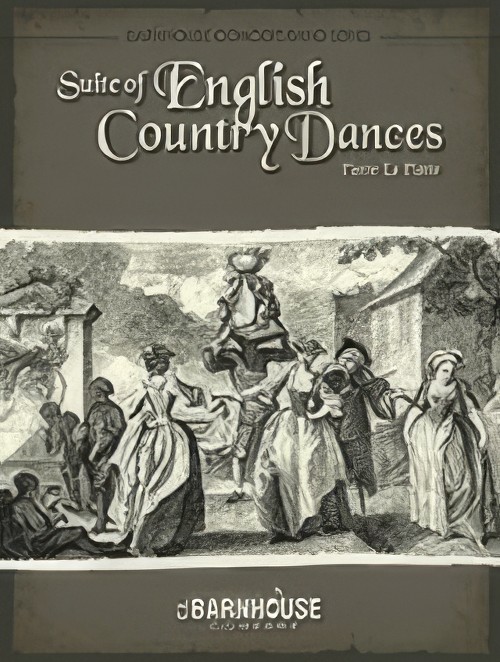 £84.00
£84.00Suite of English Country Dances (Concert Band - Score and Parts) - La Plante, Pierre
Take a musical journey back to merry olde England with Suite of English Country Dances! The movements bear the names and capture the personalities of Robin Hood, Polly Oliver/Jenny Jones and a roguish country lad, The Curly Headed Plowboy. Pierre La Plante is a master at scoring folksongs for concert band, and this delightful work showcases his virtuosity at its best. A thoroughly enjoyable programmatic selection for performers and audiences alike, this work is certain to become yet another Pierre La Plante band classic. Our highest recommendation! Duration: 7.00
Estimated dispatch 7-14 working days
-
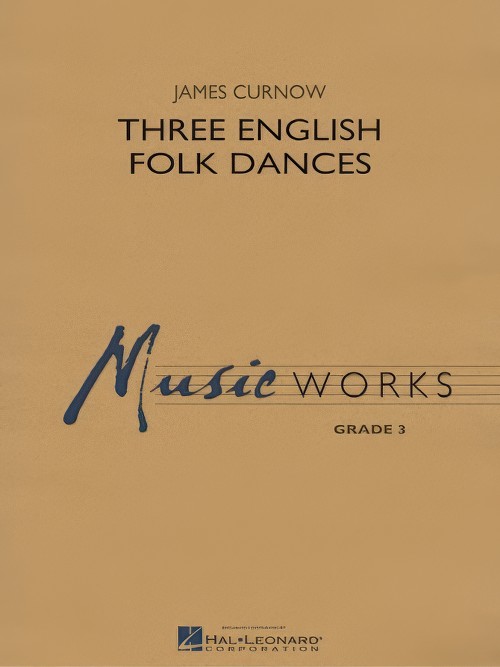 £64.99
£64.99Three English Folk Dances (Concert Band - Score and Parts) - Curnow, James
This nicely paced and skilfully orchestrated suite characterises the three main categories of ancient English folk dances. The opening Sword Dance is lively in nature and contrasts with the WaltzSong style of the second movement. The concluding movement is a Morris Dance, typified by a rustic nature and dancers with pads of bells to accentuate the rhythm. The result is an elegant work for band with vibrancy and energy.Duration: 4:30
Estimated dispatch 7-14 working days
-
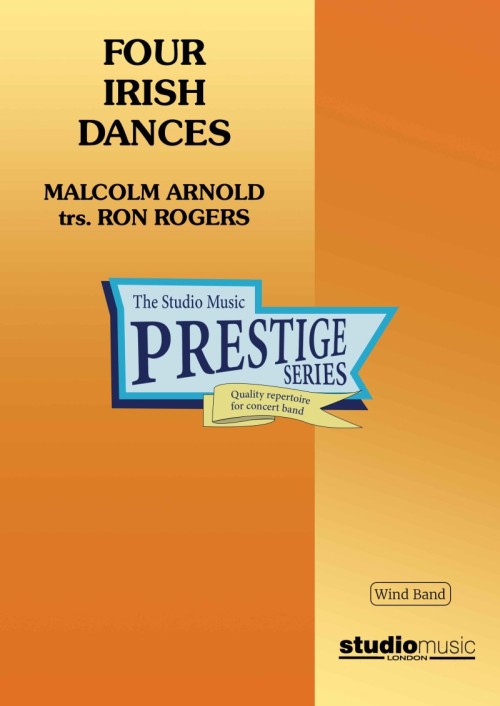 £112.95
£112.95Four Irish Dances (Prestige Concert Band - Score and Parts) - Arnold, Malcolm - Rogers, Ron
Malcolm Arnold's Four Irish Dances are from the latter stage of his career. The 1986 piece complements his other regional dance suites for orchestra, including Cornish, English and Scottish dances, though it darker in mood and colour. Stomping brass and drums in the opening Allegro con Energico give way to two spare middle movements: a Comodo made from anguished melodic imitation and a lilting Piacevole with eerie solo piccolo and miniature trio for trumpets. The 11 minute piece concludes with a wild, contrapuntal jig in triple time.The original orchestra version of the work was premiered at the Leeds Castle Festival on 10 October 1987, by the Wren Orchestra conducted by the composer.
Estimated dispatch 7-14 working days
-
 £22.95
£22.95Four Irish Dances (Prestige Concert Band - Score only) - Arnold, Malcolm - Rogers, Ron
Malcolm Arnold's Four Irish Dances are from the latter stage of his career. The 1986 piece complements his other regional dance suites for orchestra, including Cornish, English and Scottish dances, though it darker in mood and colour. Stomping brass and drums in the opening Allegro con Energico give way to two spare middle movements: a Comodo made from anguished melodic imitation and a lilting Piacevole with eerie solo piccolo and miniature trio for trumpets. The 11 minute piece concludes with a wild, contrapuntal jig in triple time.The original orchestra version of the work was premiered at the Leeds Castle Festival on 10 October 1987, by the Wren Orchestra conducted by the composer.
Estimated dispatch 7-14 working days
-
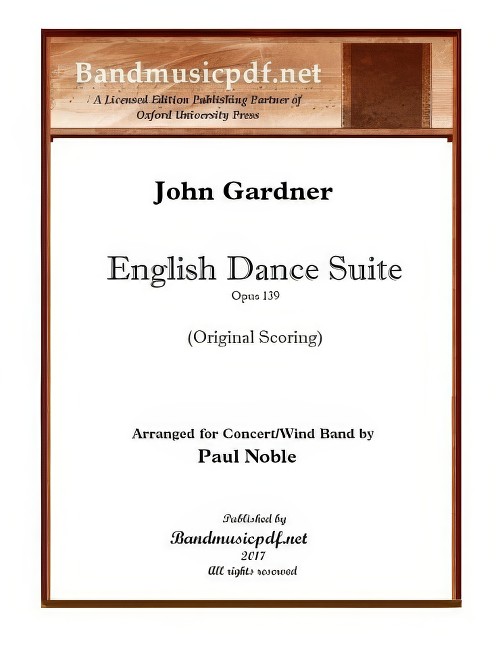 £495.00
£495.00English Dance Suite (Concert Band - Score and Parts) - Gardner, John - Noble, Paul
Original Scoring. Arranged for the modern Concert/Wind Band, scored for three trumpets, reasonable doubling of parts where the original musical effect is not altered so that players can have a more responsible and enjoyable experience, more legible parts with less doubling on one staff, etc. The piece is offered either as a complete suite of seven movements, and also as seven individual movements which may be purchased independently. The English Dance Suite was originally composed by John Gardner for Wind Band, and has been re-set for the modern Concert Band instrumentation. Both the original version, edited and type-set by Paul Noble, and this arrangement are first editions now available for purchase to bands around the world. The set of seven Renaissance dances depict John Gardner's love of Scottish music, the Renaissance heritage, and some of his own mischievous approach to music. The first movement, Chacony on a Golden Theme, reminiscent of the Allegro movement of Purcell's Golden Sonata, is much used as a vehicle for variation on a repeated short harmonic progression, often involving a fairly short repetitive bass-line which offered a compositional outline for variation, decoration, figuration and melodic invention. In this it closely resembles the passacaglia. The Alman originated in the 16th century as a duple metere dance of moderate tempo, already considered very old, with a characteristic double-knocking upbeat of one or occasionally three sixteenth notes. It appears to have derived from a German dance but no identifiable dance and no German dance instructions from this era survive. The Hornpipe, usually in 3/2 dance rhythm, is an Irish, Scottish and English dance. It is done in hard shoes, which are used to help keep track of how the dancer keeps in time. There are two variations of the hornpipe dance: fast and slow. Usually, more experienced dancers will do the slow hornpipe but younger dancers will start out with the fast hornpipe and then switch in later years. The Corranto is a 16th-century court dance characterized by short advances and retreats, in quick triple time. The Volta (Italian: the turn or turning) is an anglicised name from the later Renaissance. Its main figure consisted of a turn and lift in a sort of closed position. The Pavan is a slow processional dance common in Europe during the 16th century. The Reel, indigenous to Scotland, consists largely of quaver (eighth note) movement with an accent on the first and third beats of the bar.
Estimated dispatch 7-14 working days
-
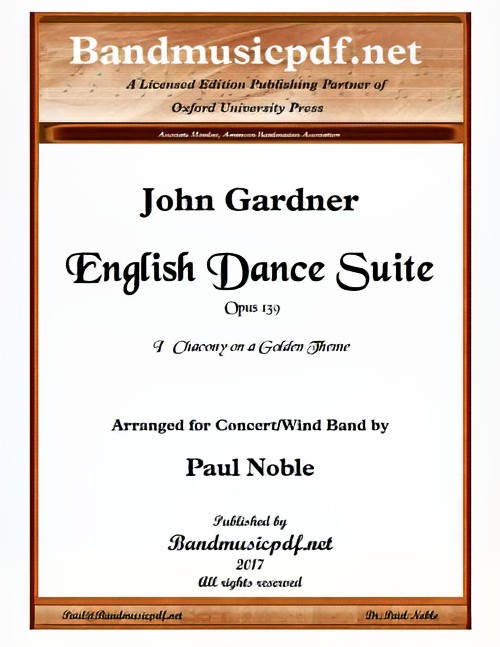 £125.00
£125.00English Dance Suite - I. Chacony on a Golden Theme (Concert Band - Score and Parts) - Gardner, John - Noble, Paul
Arranged for the modern Concert/Wind Band, scored for three trumpets, reasonable doubling of parts where the original musical effect is not altered so that players can have a more responsible and enjoyable experience, more legible parts with less doubling on one staff, etc. The piece is offered either as a complete suite of seven movements, and also as seven individual movements which may be purchased independently. The English Dance Suite was originally composed by John Gardner for Wind Band, and has been re-set for the modern Concert Band instrumentation. Both the original version, edited and type-set by Paul Noble, and this arrangement are first editions now available for purchase to bands around the world. The set of seven Renaissance dances depict John Gardner's love of Scottish music, the Renaissance heritage, and some of his own mischievous approach to music. The first movement, Chacony on a Golden Theme, reminiscent of the Allegro movement of Purcell's Golden Sonata, is much used as a vehicle for variation on a repeated short harmonic progression, often involving a fairly short repetitive bass-line which offered a compositional outline for variation, decoration, figuration and melodic invention. In this it closely resembles the passacaglia. The Alman originated in the 16th century as a duple metere dance of moderate tempo, already considered very old, with a characteristic double-knocking upbeat of one or occasionally three sixteenth notes. It appears to have derived from a German dance but no identifiable dance and no German dance instructions from this era survive. The Hornpipe, usually in 3/2 dance rhythm, is an Irish, Scottish and English dance. It is done in hard shoes, which are used to help keep track of how the dancer keeps in time. There are two variations of the hornpipe dance: fast and slow. Usually, more experienced dancers will do the slow hornpipe but younger dancers will start out with the fast hornpipe and then switch in later years. The Corranto is a 16th-century court dance characterized by short advances and retreats, in quick triple time. The Volta (Italian: the turn or turning) is an anglicised name from the later Renaissance. Its main figure consisted of a turn and lift in a sort of closed position. The Pavan is a slow processional dance common in Europe during the 16th century. The Reel, indigenous to Scotland, consists largely of quaver (eighth note) movement with an accent on the first and third beats of the bar.
Estimated dispatch 7-14 working days
-
 £75.00
£75.00English Dance Suite - II. Alman (Concert Band - Score and Parts) - Gardner, John - Noble, Paul
Arranged for the modern Concert/Wind Band, scored for three trumpets, reasonable doubling of parts where the original musical effect is not altered so that players can have a more responsible and enjoyable experience, more legible parts with less doubling on one staff, etc. The piece is offered either as a complete suite of seven movements, and also as seven individual movements which may be purchased independently. The English Dance Suite was originally composed by John Gardner for Wind Band, and has been re-set for the modern Concert Band instrumentation. Both the original version, edited and type-set by Paul Noble, and this arrangement are first editions now available for purchase to bands around the world. The set of seven Renaissance dances depict John Gardner's love of Scottish music, the Renaissance heritage, and some of his own mischievous approach to music. The first movement, Chacony on a Golden Theme, reminiscent of the Allegro movement of Purcell's Golden Sonata, is much used as a vehicle for variation on a repeated short harmonic progression, often involving a fairly short repetitive bass-line which offered a compositional outline for variation, decoration, figuration and melodic invention. In this it closely resembles the passacaglia. The Alman originated in the 16th century as a duple metere dance of moderate tempo, already considered very old, with a characteristic double-knocking upbeat of one or occasionally three sixteenth notes. It appears to have derived from a German dance but no identifiable dance and no German dance instructions from this era survive. The Hornpipe, usually in 3/2 dance rhythm, is an Irish, Scottish and English dance. It is done in hard shoes, which are used to help keep track of how the dancer keeps in time. There are two variations of the hornpipe dance: fast and slow. Usually, more experienced dancers will do the slow hornpipe but younger dancers will start out with the fast hornpipe and then switch in later years. The Corranto is a 16th-century court dance characterized by short advances and retreats, in quick triple time. The Volta (Italian: the turn or turning) is an anglicised name from the later Renaissance. Its main figure consisted of a turn and lift in a sort of closed position. The Pavan is a slow processional dance common in Europe during the 16th century. The Reel, indigenous to Scotland, consists largely of quaver (eighth note) movement with an accent on the first and third beats of the bar.
Estimated dispatch 7-14 working days
-
 £110.00
£110.00English Dance Suite - III. Hornpipe (Concert Band - Score and Parts) - Gardner, John - Noble, Paul
Arranged for the modern Concert/Wind Band, scored for three trumpets, reasonable doubling of parts where the original musical effect is not altered so that players can have a more responsible and enjoyable experience, more legible parts with less doubling on one staff, etc. The piece is offered either as a complete suite of seven movements, and also as seven individual movements which may be purchased independently. The English Dance Suite was originally composed by John Gardner for Wind Band, and has been re-set for the modern Concert Band instrumentation. Both the original version, edited and type-set by Paul Noble, and this arrangement are first editions now available for purchase to bands around the world. The set of seven Renaissance dances depict John Gardner's love of Scottish music, the Renaissance heritage, and some of his own mischievous approach to music. The first movement, Chacony on a Golden Theme, reminiscent of the Allegro movement of Purcell's Golden Sonata, is much used as a vehicle for variation on a repeated short harmonic progression, often involving a fairly short repetitive bass-line which offered a compositional outline for variation, decoration, figuration and melodic invention. In this it closely resembles the passacaglia. The Alman originated in the 16th century as a duple metere dance of moderate tempo, already considered very old, with a characteristic double-knocking upbeat of one or occasionally three sixteenth notes. It appears to have derived from a German dance but no identifiable dance and no German dance instructions from this era survive. The Hornpipe, usually in 3/2 dance rhythm, is an Irish, Scottish and English dance. It is done in hard shoes, which are used to help keep track of how the dancer keeps in time. There are two variations of the hornpipe dance: fast and slow. Usually, more experienced dancers will do the slow hornpipe but younger dancers will start out with the fast hornpipe and then switch in later years. The Corranto is a 16th-century court dance characterized by short advances and retreats, in quick triple time. The Volta (Italian: the turn or turning) is an anglicised name from the later Renaissance. Its main figure consisted of a turn and lift in a sort of closed position. The Pavan is a slow processional dance common in Europe during the 16th century. The Reel, indigenous to Scotland, consists largely of quaver (eighth note) movement with an accent on the first and third beats of the bar.
Estimated dispatch 7-14 working days
